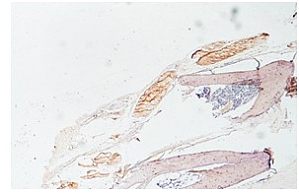Lysing of a complete biopsy sample results in a mixture of desired and undesired proteins, reflecting the originating cell types. Therefore microdissecting tissue material is mandatory prior to sample lysis and all downstream applications of protein analysis (proteomics). The two m ...
The ability to define protein profiles of normal and diseased cells is important in understanding cell function. Laser capture microdissection permits the isolation of specific cell types for subsequent molecular analysis. In this study we have established conditions for obtaini ...
The anterior pituitary gland consists of a heterogeneous population of various cell types. To study a single cell type with a homogeneous cell population, one can perform laser capture microdissection (LCM). Because different pituitary cells have unique immunophenotypic profile ...
Macrophage foam cells are critical mediators in atherosclerosis plaque development. A better understanding of the in vivo transcript profile of foam cells during the formation and progression of lesions may lead to novel therapeutic interventions. Toward this goal, we demonstrate ...
The kidney consists of many functional modules called nephrons. Each nephron has a tubular structure made up of several structurally and functionally distinct segments. The analysis of individual segments requires the use of microdissection techniques. We describe protocols th ...
Microdissection techniques have become an important tool to link histomorphology and pathophysiological events using modern methods of molecular biology. They allow isolation of cell clusters or even single cells precisely under optical control from complex tissue structu ...
Laser-assisted microdissection has enabled the collection of morphologically defined cell populations from a tissue section. The PALM� Robot MicroBeam laser microdissection system provides a robust system for the retrieval of specified cells (including single cells). Due to t ...
Laser microbeam microdissection (LMM) is an increasingly important histological technique for obtaining homogeneous cell populations and tissue components in order to analyze target-specific changes in genes, gene expression, and proteins. The quality of data obtained with ...
Biological tissues (in particular those affected by disease) are inherently complex mixtures of different cell types and matrices. This heterogeneity can complicate the interpretation of molecular biological studies performed on whole-tissue extracts if the precise cellu ...
Single palpable nodules of the thyroid gland are common in clinical practice; the majority of such lesions are benign. However, noninvasive thyroid nodules that exhibit borderline morphological signs of papillary cancer represent a diagnostic challenge. Rearrangements of the RET ...
Microsatellite analysis is a frequently used method for detection of chromosomal deletions by loss of heterozygosity studies and for detection of microsatellite instability. For reliable microsatellite analyses, a tumor cell content of at least 80% is required. Therefore, laser m ...
Laser microdissection is an essential method for the investigation of the multistep carcinogenic process in the urinary bladder. Reliable detection of tumor-specific alterations which can be compromised by the presence of normal cells, requires microdissection of pure tumor ce ...
Laser-based microdissection technologies have been recently developed and applied to procure homogenous populations of tumor cells from paraffin-embedded and frozen tissue sections. When combined with whole-genomic amplification techniques, sufficient amounts of D ...
Efficient detection of somatic mutations is important for the development of clinical molecular diagnostic assays. However, the detection of somatic mutations in tissue is confounded by dilution of the tumor cell population by normal cells. Laser microdissection allows enrichm ...
Comparative genomic hybridization (CGH) is a powerful screening technique that can identify regions of gain and loss within the whole genome in a single experiment. The combination of laser capture microdissection, whole-genome amplification, and CGH permits genomic screening w ...
This chapter describes a method for the rapid assessment of gene copy number in laser microdissected material using multiplex real-time polymerase chain reaction (PCR). Here a putative oncogene (ZNF217) was evaluated in a series of colon tumors, but the method is applicable to any locus for wh ...
We have found methacarn, a non-crosslinking protein-precipitating fixative, to be useful for the analysis of DNA from microdissected specimens of wax-embedded tissue. In this chapter, we present the procedure regarding genomic DNA analysis in methacarnfixed wax-embedded micro ...
The development and application of laser-based tissue microdissection techniques has provided a major impetus to the sensitive and specific molecular analysis of solid tissues and tumors. This chapter provides an overview of the different laser-based microdissection systems ...
相关专题 生命科学及金属材料分析等科研领域,能否重现目镜中观察到的真实色彩,是CCD优劣的最重要的评判标准。 那如何评价一个相机的色彩还原效果呢?例如右图,一方面,可以通过对比目镜,看看显微相机中拍出的图像和眼睛看到的是否一致;那专业相机研发团队如何保证显微相机的色彩还原(准确)度呢? 色彩准确度 什么叫色彩准确度?简单说,就是拍出来的色彩正不正,红色是不是红色,蓝色是不是蓝色,白色是不是白色。那么怎么评价色彩正不正呢? 我们以国内专 ...
The study of genes that are expressed only, or with unique effects, in the nervous system has become important from both a molecular biological and a clinical perspective. From knowledge of the structure of a gene and its exons, it is possible to identify






